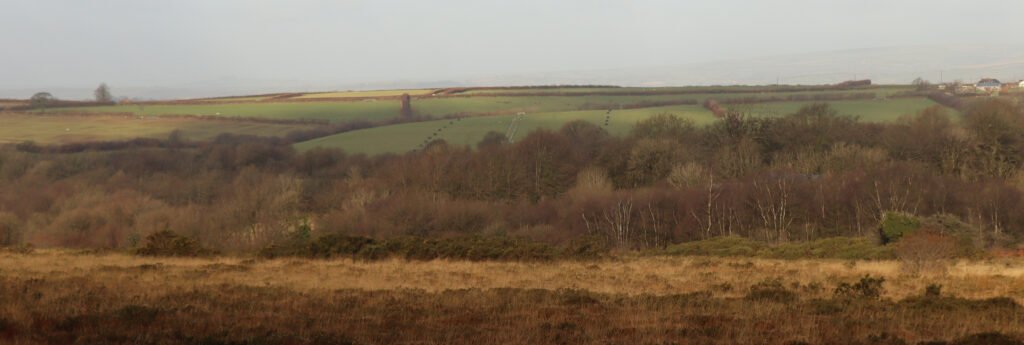Higher Comfort Nature Reserve is situated where the Two Moors Way enters the SSSI, which is the largest area of culm grassland left in existence. It’s just over a hectare in size (2.6 acres) and is Devon Culm’s first nature reserve, having been purchased in December 2024. It is not yet open to the public, as we first need to create access. We are currently in the stage of observing the site and creating a design which preserves and enhances existing habitats and provides new habitats. Although it is mainly wooded, it has some culm grassland species, such as greater birdsfoot trefoil and marsh/fen bedstraw.

The name “Higher Comfort Nature Reserve” is based on the names of the two closest farms. Great Comfort Farm is just on the other side of the River Sturcombe. Little Comfort Farm was an Elizabethan farm, which fell into disuse many years ago and became derelict. The remains were uncovered by Devon Wildlife Trust in 2011 when they were clearing scrub. It was below Devon Culm’s nature reserve, on Knowstone Outer Moor. The field patterns of Little Comfort Farm can still be seen and it is now a wildlife-rich section of the moorland. With our newly bought nature reserve being at a higher altitude than either Great or Little Comfort, Higher Comfort Nature Reserve was chosen unanimously by the trustees.

The position of Higher Comfort Nature Reserve is strategically important. It’s adjacent to Knowstone Outer Moor, which is one of 4 moors, which make up the largest contiguous area of culm grassland, left in existence. Between them, they cover 122 hectares (300 acres). Most of the moor is owned by Devon Wildlife Trust. Hares Down is owned by Knowstone Parish Council and there is a small, privately owned section. The moors are designated as a site of special scientific importance (SSSI) and a special area of conservation (SAC) and as such, are managed for wildlife.

A major environmental issue with the moors is that they are open to the public and therefore have pressure from dogs and humans. Signs have been erected, asking that dogs are kept on a lead at all times, but they are widely ignored and dogs are often seen running freely through the culm grassland. This presents issues for a number of species. Ground nesting birds may have their nests disturbed, preventing them from reproducing. Overwintering birds, such as woodcocks will use up more energy if they are regularly disturbed and may be unable to regain this energy from the food which is available in the winter. There are also issues around the use of wormers and flea treatments, which are poisons, which spread into the natural environment.

Higher Comfort Nature Reserve offers a refuge for nature. It is undisturbed by humans and dogs and most of the nature reserve is contained within a high fence. Viewing areas will be created, outside the fence, which will allow the public to look in and observe wildlife without disturbing it. Within the fenced area, there will be a combination of wooded areas and open grassland, providing vital habitats for species, found on the adjoining SSSI.
As well as being adjacent to the SSSI, Higher Comfort Nature Reserve is also adjacent to the Two Moors Way. We intend to create two access points, so walkers can step off the Two Moors Way into the nature reserve, walk along the edge, past viewing points and rejoin the Two Moors Way at the other end. They will then be able to stop at viewing points, to observe the wildlife within.

The site is part of a woodland that was planted in the early 2000s. It had been sold with plans to plant it up as a coniferous woodland, but the previous owner changed this to a mainly deciduous woodland, with the intention that it would be good for wildlife as well as sequestering carbon. This change was a great step forward for nature, but due to its location next to a grassland SSSI, it would have been better to have created a more open landscape. The previous owner is very supportive of Devon Culm and sold us the land for half of the price it was valued at. If the site was ancient woodland when we bought it, we would definitely have kept it as ancient woodland. Similarly, if it was culm grassland, we would have kept it as such.

Culm grassland should contain tree cover. Ideally, it should be between 5 and 25% tree cover and woodland on this site will ultimately develop into Atlantic temperate rainforest, which is a valuable habitat in itself. Trees in a culm landscape provide roosts, perches, nest sites and places to hide for a wide variety of species. We intend to find a balance between tree cover and grassland habitats. We will do so, taking account of its context within the surrounding habitats.

The fact that it is such a young woodland which hasn’t developed a mature and balanced ecosystem, gives us options. Every decision made about habitat management will benefit some species at a cost to others. For this reason, we need to be careful about the decisions we make. Our intention is to reduce tree cover within the nature reserve. Our observations and discussions with the Forestry Commission will determine to what extent we will do so.
We want to involve the local community in the management of Higher Comfort nature reserve as much as possible, with volunteers surveying the land and carrying out the work that is necessary to establish and maintain habitats. We also encourage the community to give us feedback and ideas, by emailing us at info@devonculm.org.uk
